In the majestic Santa Cruz Mountains, under the canopy of ancient redwoods at Redwood Glen Camp, we were able to attend Coyne Survival School Survival Skills Certification course. It was a healthy blend of wilderness survival basics intertwined with life saving first aid knowledge. Everyone who attended not only leveled up their survival game, but walked away with a Red Cross Wilderness First Aid certification. Here's how to blend know-how and practicality with a dash of intuition when you're stepping away from the comfort of civilization.
The Bow Drill
Ah, the bow drill—a primitive yet effective way to spark a fire when you're out in the wild. Picture this: you're surrounded by nature's grandeur, and all you've got are your wits and whatever you can find in your surroundings. No fancy lighters or waterproof matches here. The bow drill is all about mastering the art of friction to ignite that life-giving flame.
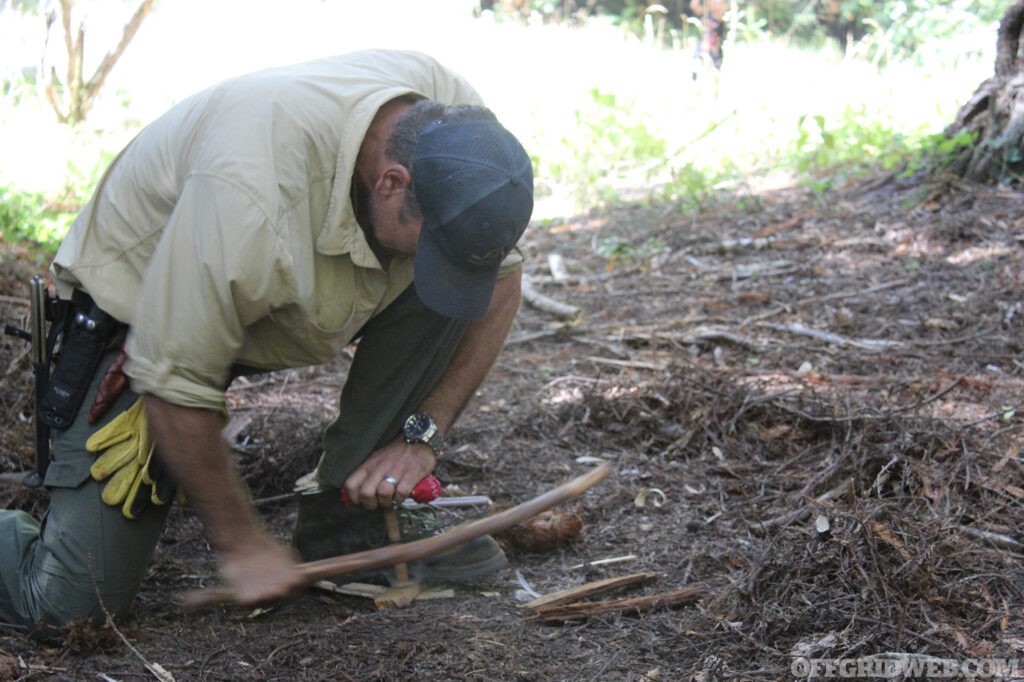
Above: Instructor Adam Mayfield demonstrates how to produce a friction fire by using a bow drill.
To create fire with nothing but friction, you'll need the right materials. Components are the easy part: all that is required is a bow, a spindle, a fireboard, and a bearing block. For the bow, a slightly curved, sturdy stick about arm's length will do. The spindle should be a straight, dry stick, roughly thumb-thick and about as long as your hand. Your fireboard can be a flat piece of wood, and the bearing block can be another piece of wood or even a stone with a depression for the spindle to sit in. To turn the spindle, a cord is strung to the bow and wrapped around the center of the spindle. It's held in place between the fireboard and bearing block and rotated quickly by pushing and pulling the bow back and forth.
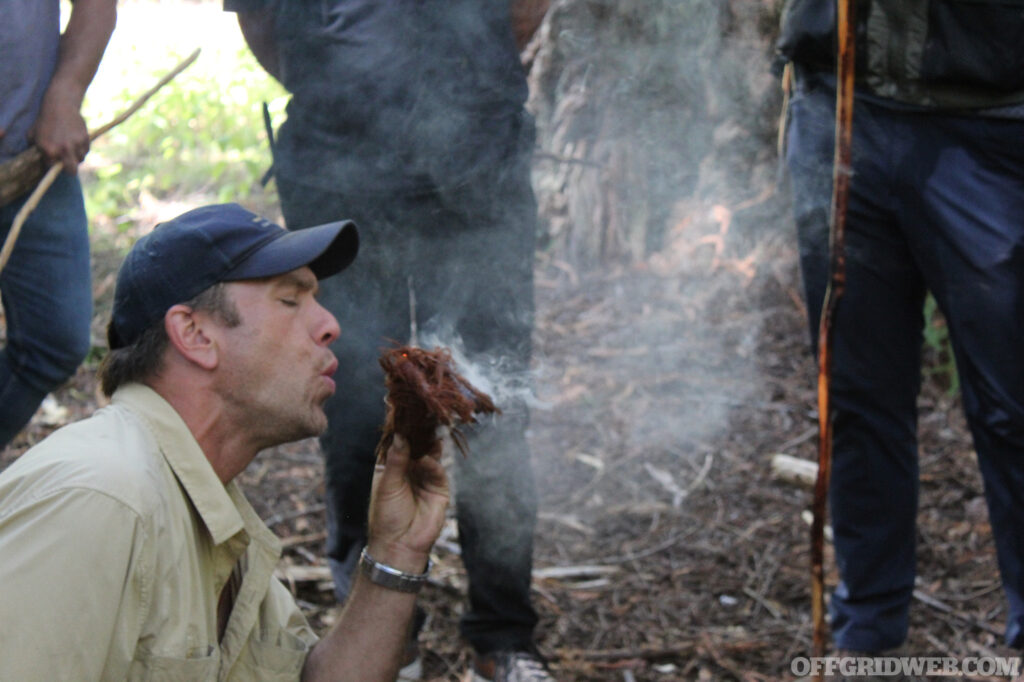
Above: Once a glowing ember is placed in a tinder bundle, it must be supplied with a gentle flow of oxygen to ignite into flame.
The trickiest part is finding the materials for the spindle and fireboard, because as the two rub against each other, they create an ignitable charred powder. Some woods produce this powder better than others. Unfortunately, we had primarily redwood for materials, and the tannins in the wood make them naturally fire resistant. That didn't stop several of us from getting a fire going though, albeit with a little extra effort. Once enough charred powder is produced, the heat should eventually light into a smoldering ember. This ember is transferred gently to a tinder bundle and coaxed into a flame that can be used to get your campfire roaring.
Go Slow to Go Far
This isn't just a catchy phrase, it's a survival mantra. When you're out in the wild, especially in a group, the pace can make or break your journey. The slowest member sets the speed, and that's not just being polite—it's strategic. In survival situations, pushing too hard can lead to exhaustion, dehydration, or even injury. On top of that, nobody wants to deal with a sprained ankle miles away from the nearest trailhead due to trying to impress others in your group with how fast you can go.
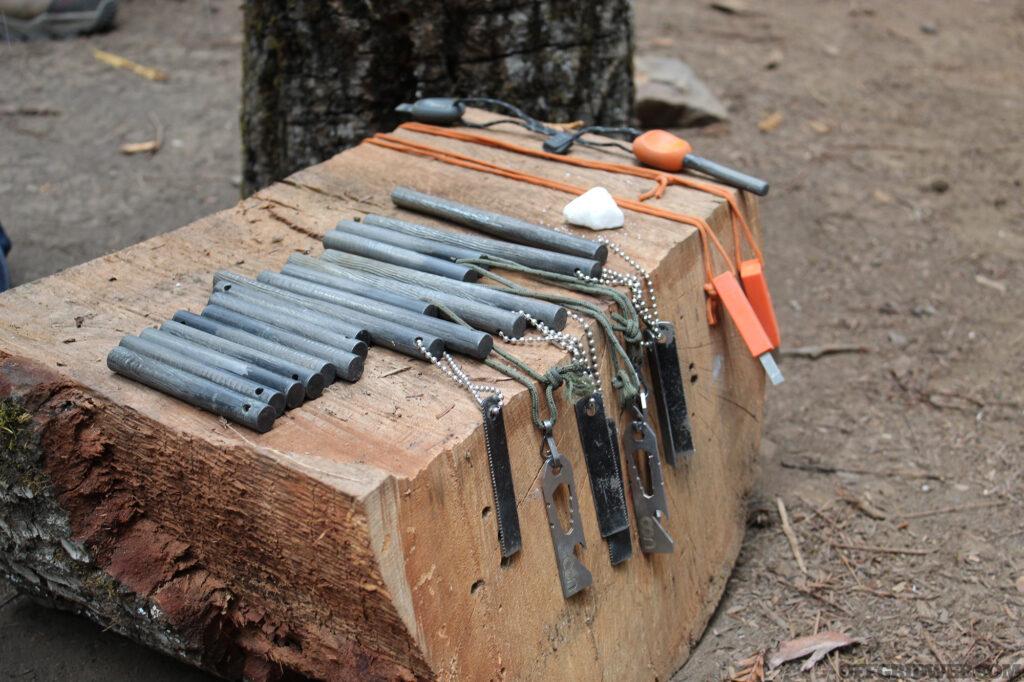
Above: Ferro rods come in in all shapes and sizes, but their function is the same; scrape and create sparks.
Weather is another factor that can turn on you like a dime. One minute it's sunny, and the next, you're caught in a downpour or a sudden temperature drop. In such conditions, rushing can lead to mistakes, and mistakes can be costly. For instance, in hot weather, moving too fast can lead to heat exhaustion or worse, heat stroke. In cold conditions, you risk hypothermia if you sweat too much and then get chilled.
Keep an eye on everyone's condition. Make regular stops to hydrate, snack, and check for signs of fatigue or discomfort. If someone's lagging, don't view it as a hindrance; see it as a natural speed limit that's keeping everyone safer. Adapt your pace, keep tabs on the weather, and remember: it's a marathon, not a sprint. You're out there to enjoy nature and make it back in one piece, not set a land-speed record.
Avoiding Exposure
When you're out in the wild, your body's internal thermostat is your best friend and worst enemy. Trouble occurs when your body can no longer thermoregulate its core temperature and succumbs to one of the two extremes: hypothermia and hyperthermia.
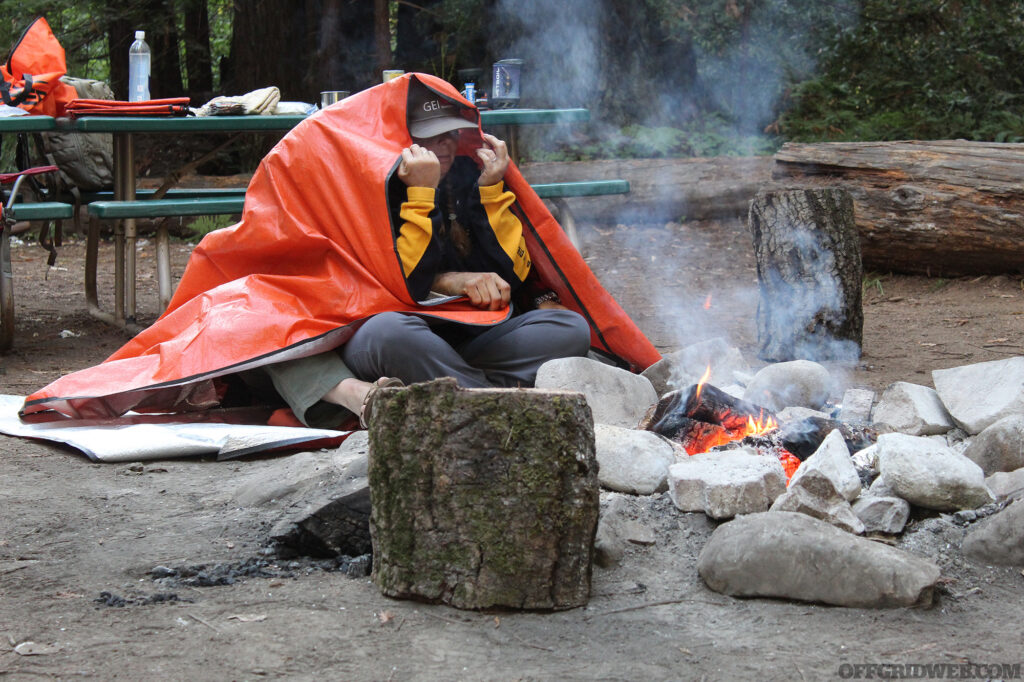
Above: Instructors Adam and Amy demonstrate the sitting position used to combat hypothermia.
Hypothermia is when your body loses heat faster than it can produce it, causing your core temperature to drop dangerously low. It's not just a winter thing, you can get hypothermia in relatively mild conditions if you're wet and exposed to wind. Signs to look out for include shivering, confusion, and a gradual loss of motor skills. If you or someone in your group starts showing these symptoms, it's time to act. Get to shelter, change into dry clothes, and warm up with warm drinks and high-energy foods.
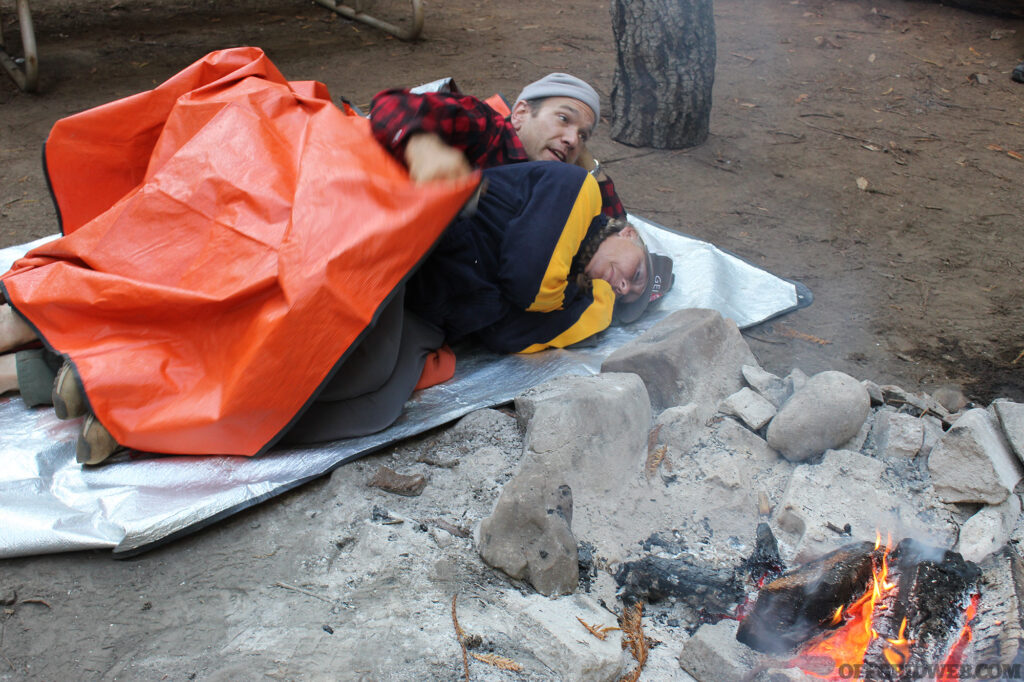
Above: Utilizing thermal blankets and leveraging the heat our body's radiate naturally can help reverse the effects of hypothermia.
Hyperthermia, on the other hand, is the opposite problem. This happens when your body overheats, usually due to excessive physical exertion in hot conditions. Symptoms include heavy sweating followed by a lack of sweat, rapid pulse, and disorientation. Immediate steps include finding shade, hydrating with water and electrolytes, and cooling down the body by any means possible—think wet cloths or even a dip in a stream if it's safe.
The key to managing both is to focus on the areas where your body's major veins (the vessels that carry blood back to the heart) come close to the surface of your skin: the neck, armpits, and groin. These are your body's natural thermostats. Cooling or warming these areas can help regulate your core temperature more efficiently. And if you're using hand warmers, wrap them in cloth to avoid contact burns.
Surviving the Scene
Survival isn't just about gear and know-how, it's also about mindset. Emergencies are rarely penciled into your calendar, and they usually happen due to a combination of factors like faulty gear, overestimating your skills, or just plain not knowing what you're doing. So, how do you “crack the code” to survive the scene?
First, self-Assessment. Take a moment to assess your situation. Are you lost? Injured? Low on supplies? Knowing your status helps you prioritize your next steps. If you're lost, your first move might be to find a vantage point for better orientation. If you're injured, immediate first aid is your priority.
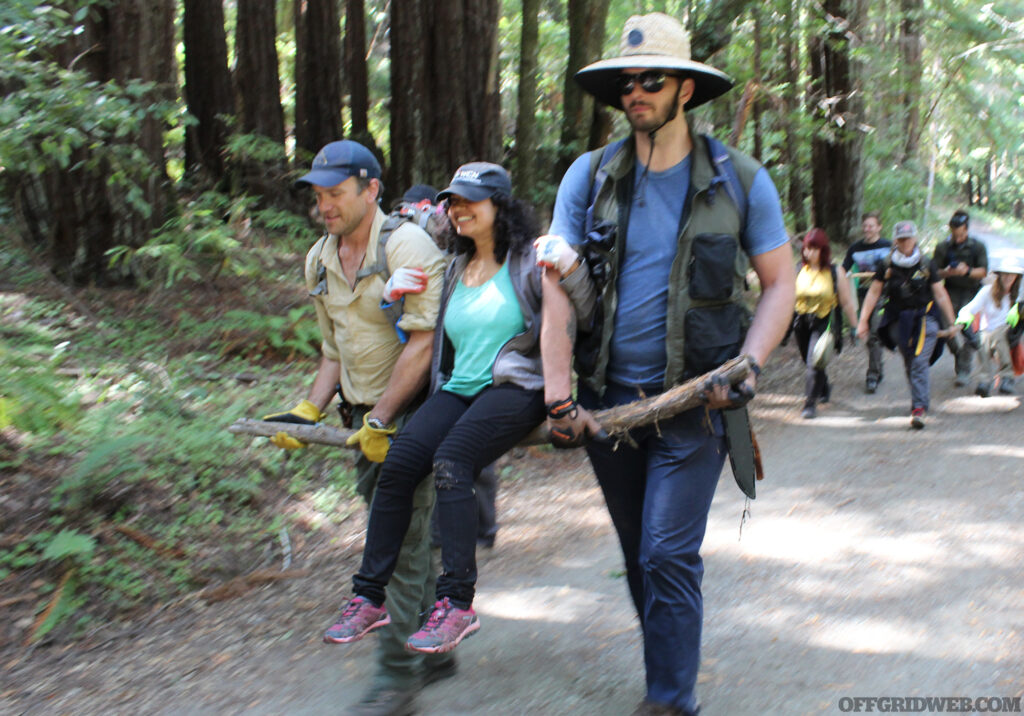
Above: Students at the Survival Skills Certification course use improvised litters to move patients with mock injuries from one point to another.
Next, adaptability. Nature is unpredictable, and your initial plans may not always pan out. Maybe the trail is blocked, or perhaps a sudden storm rolls in. Being able to adapt to changing conditions is crucial. This could mean setting up an impromptu shelter or finding an alternative route.
Resourcefulness is another key. Use what you have, but also use what you find. A broken backpack strap could be repurposed as a tourniquet, or a lens from your sunglasses could be used to start a fire.
Lastly, breathing. It might sound trivial, but controlled breathing can help reduce stress, override the amygdala—the part of your brain that governs emotional responses like fear and panic—and improve decision-making.
Sending the Right Signals
If you find yourself in a situation where you need to be rescued, effective signaling is crucial. The universal distress signal is a series of three of anything—three whistle blasts, three fires, three rock piles, and so on. But to really draw a searchers attention, using a series of the large contrasting triangles could be a real game changer.
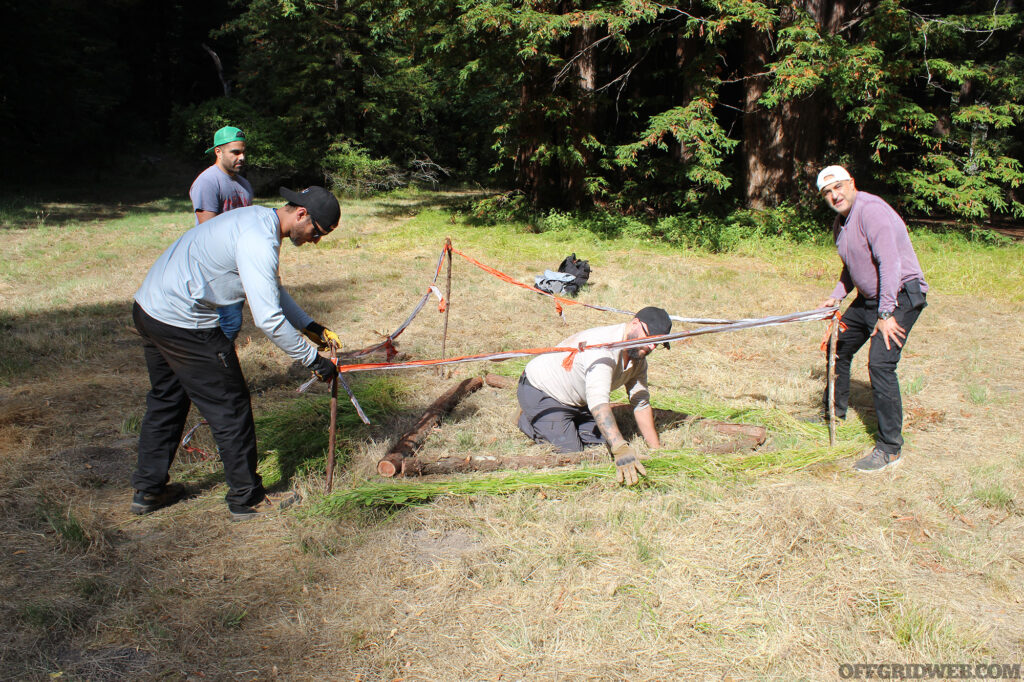
Above: A series of three large triangles help attract the attention of both air and ground searchers to your location.
Why triangles? Because they're an uncommon shape in nature and easily catch the eye. Create three large triangles on the ground using materials that contrast with the natural surroundings. Think dark rocks on a sandy beach or logs on a snowy field. Make them big, at least several feet across, and space them out so they're easily visible from the air or a distance. Things like brightly colored flagging tape or strips of reflective emergency shelter material can be used to enhance the visual attractiveness of these types of signals.
If you have a mirror or any reflective surface, use it to catch the sun and aim the reflection toward searchers. The glint can be seen for miles and is another effective way to signal for help.
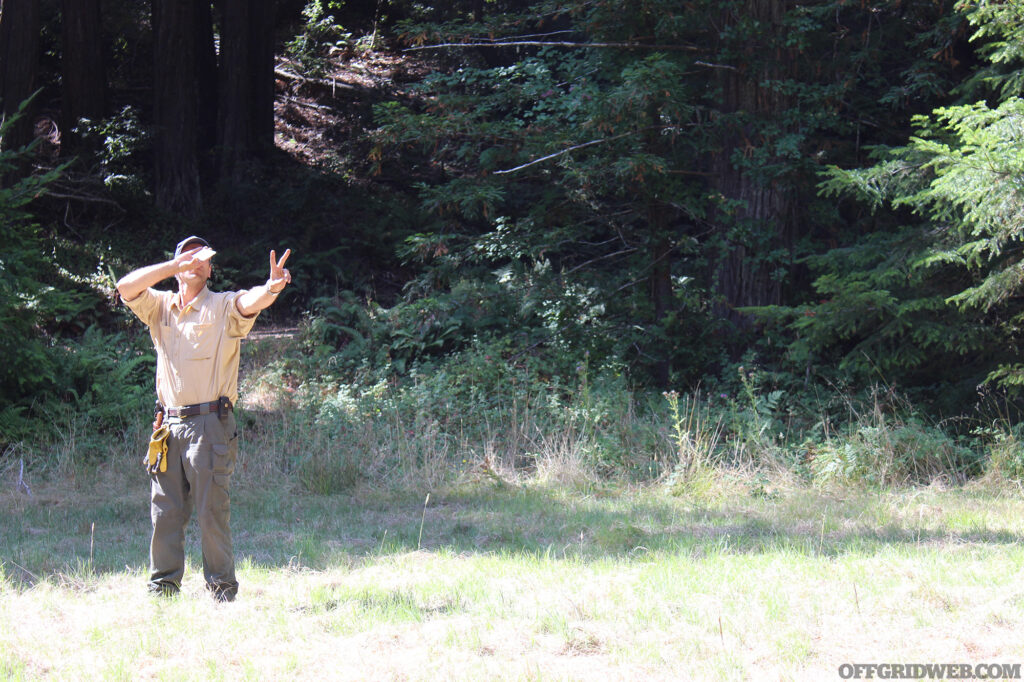
Above: Once you find the reflected light from your signal mirror, using your fingers as a sight can help you aim where the light is being directed.
And don't forget about sound signals. Three loud, short blasts on a whistle can carry over long distances, depending on surrounding vegetation and topography, and are a universally recognized distress signal. In some places, three blasts could be mistaken for bird calls, and if you think you are competing with the local wildlife, one long continuous blast will definitely stand out to searchers. If you don't have a whistle, banging rocks or sticks together can also work.
Hydration
Hydration is more than just guzzling down water like there's no tomorrow. In fact, overhydration can lead to a condition called hypornatremia, where your body's sodium levels get dangerously low. So, how do you strike the right balance?
Firstly, quality over quantity. The water you consume should be clean and free from contaminants. Always carry a reliable water filter; a 0.2-micron filter is generally considered effective for removing most types of bacteria and parasites. Be advised though, unless you use a highly specialized filter, it will not kill viruses. If you don't have a filter, boiling water is the next best option, and is the only option if you're worried about viruses. Try to source your H2O from moving water, and look for places where the water is being agitated. This is because protozoa clump together, and the agitation of water flowing over rocks or logs can break those clumps up and could possibly reduce the volume of harmful microbes you have to filter or consume.
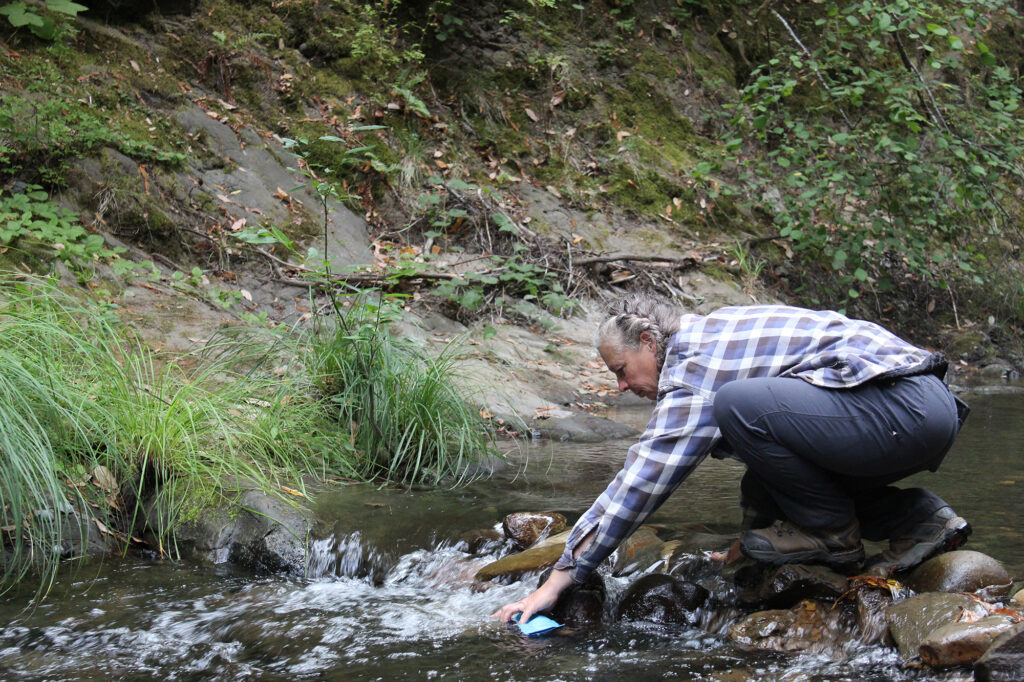
Above: Instructor Amy shows us a prefered location to collect water from a moving stream.
Electrolytes are extremely important for healthy body function. These are minerals like sodium, potassium, and magnesium that help regulate your body's fluid balance, and are responsible for your neurons communicating with each other. Consider adding an electrolyte tablet to your water every third liter, or munch on some electrolyte-rich foods like bananas or nuts.
Pacing is crucial. Don't just chug water when you're feeling parched; sip it consistently throughout your journey. This helps maintain a steady level of hydration and reduces the risk of both dehydration and overhydration.
Monitor Your Output. The color of your urine is a good indicator of your hydration level. Aim for a light yellow color; dark yellow or brown indicates dehydration, while completely clear could mean you're overhydrated.
Shelter: Debris A-Frame
When it comes to survival shelters, the Debris A-Frame is a classic. It's relatively easy to build and provides good insulation, making it a solid choice for both warm and cold climates.
First, location is key. Look for a spot that's flat and free from water runoff. Avoid areas near dead trees or large limbs—known as “widow-makers”—that could fall and cause injury.
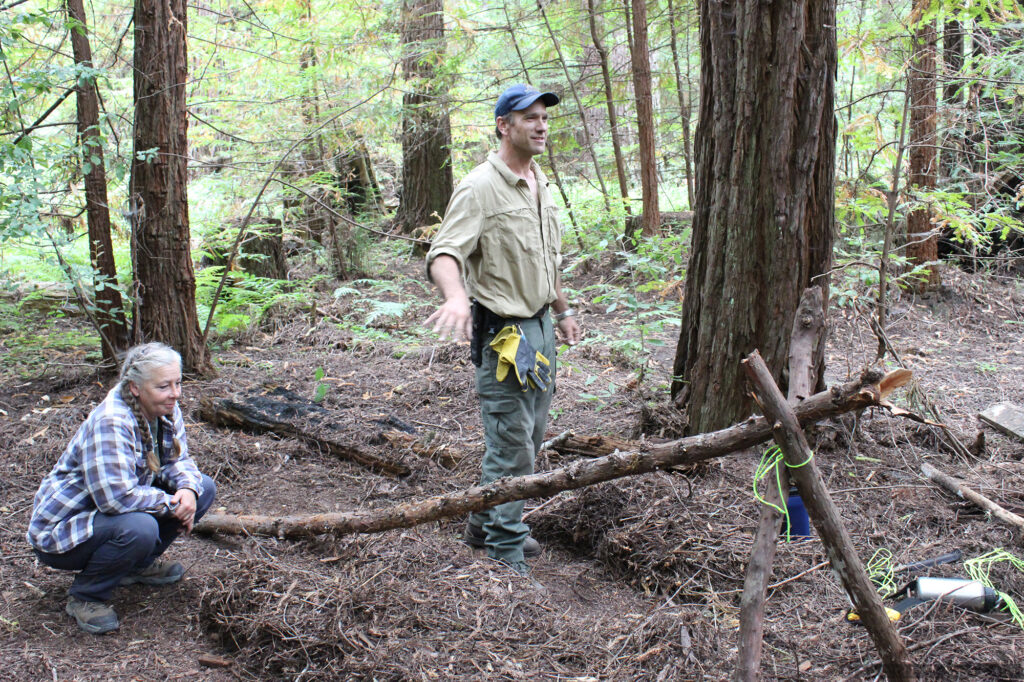
Above: After creating a “mattress” of debris from the forest floor, the A-Fram and spine is constructed directly over the top.
Materials are important, and you want to choose pieces that won't break or crumble because of rot or insect occupation. Start by creating the “A” of the A-frame with branches that will cross at roughly collar bone height. You'll need a long, sturdy ridgepole for the “spine” of your A-frame. Lean smaller sticks against it to form the “ribs,” and then pile leaves, needles and twigs from the ground to create insulation. The thicker the debris, the better the insulation. Packing the insulation tight and thick enough to prevent you from seeing light from the inside of the shelter could indicate that it has good water resistance from precipitation. Don't forget about the ground. Even with a solid roof over your head, you can lose a lot of body heat through the ground. Lay down a thick layer of leaves or pine needles to serve as a natural mattress.
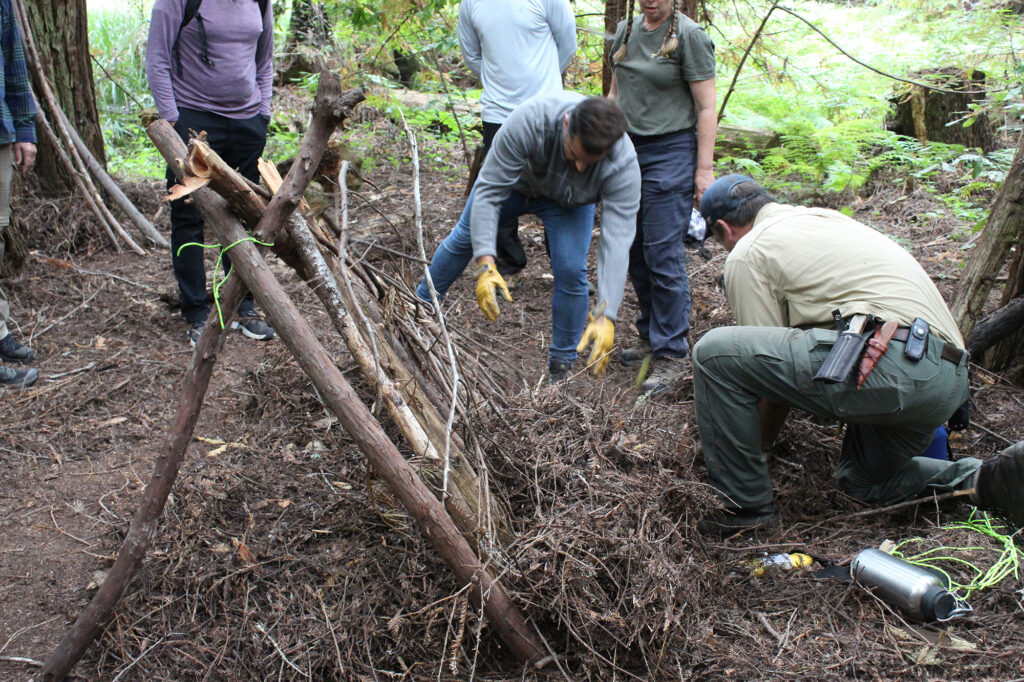
Above: Debris is collected, compressed, and stacked along the ribs of the shelter, effectively creating insulated walls.
Consider digging a small trench about 18 inches away from the entrance of your shelter. This can serve as a fire pit, providing both warmth and a cooking area. Just make sure it's well-ventilated and far enough from the shelter to prevent accidental fires. Having a small entrance to conserve heat is also a great shelter upgrade to consider. You can use additional debris, a piece of clothing, or even a makeshift door made from branches to cover the opening when you're inside.
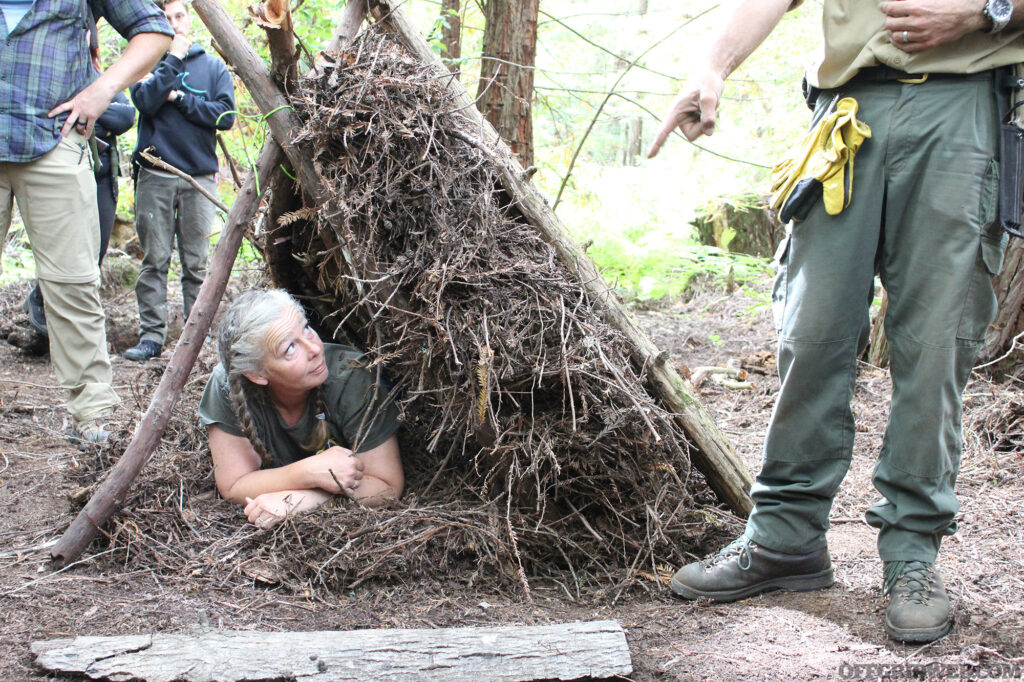
Above: Ideally, there shouldn't be too much space between your body, and the walls of the shelter.
Wilderness First Aid
When you're out in the wild, you're the first responder. There's no 911 to call, no ambulance coming to your rescue. You've got to rely on your skills, your gear, and your judgment to stabilize injuries, mitigate exposure, and initiate extrication if needed.
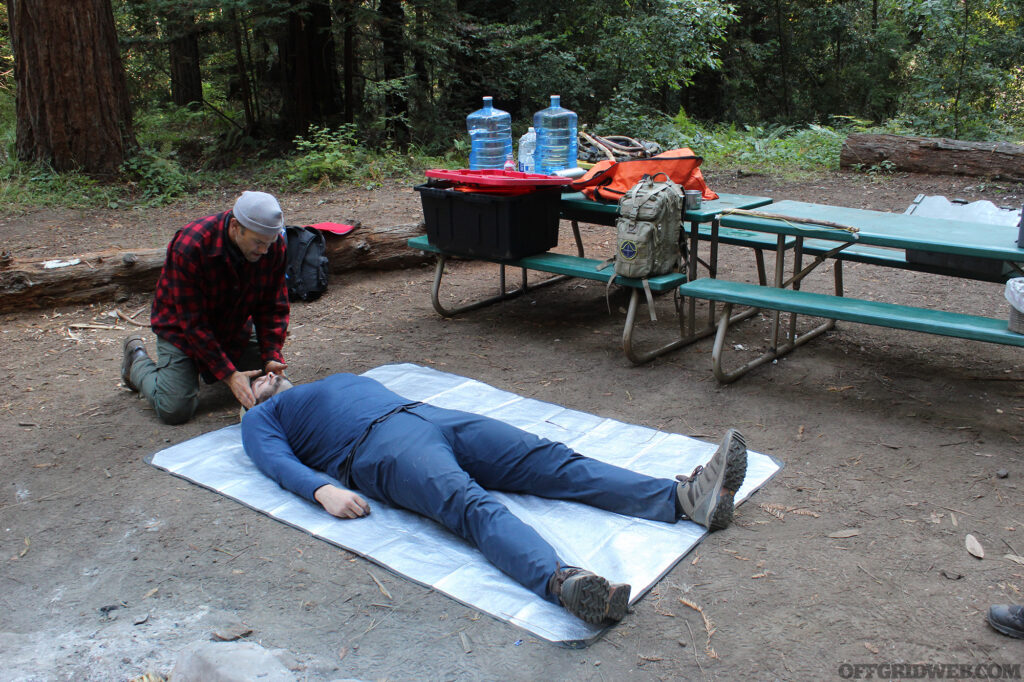
Above: Using both hands during a symmetrical patient assessment will help the assessor determine if something is wrong with either side of the body.
If you have the ability to do so, document every detail. Not only will the information be incredibly useful when the patient reaches the next level of care, but it can also protect you from liability. If you're dealing with an injury or illness, jot down the symptoms, the time they started, and any actions you've taken. This is where the SOAP acronym comes in handy:
- Subjective: What is the patient feeling? Are they in pain, dizzy, nauseous? This is the patient's account of their condition.
- Objective: These are your measurable observations. Is there swelling, a cut, or a rash? Are they breathing heavily or showing signs of dehydration? What is their heart rate?
- Assessment: Based on the subjective and objective information, what's your diagnosis? Is it a sprain, heat exhaustion, or something more serious?
- Plan: What are you going to do about it? This could range from applying a bandage or splint to deciding that immediate evacuation is necessary.When in doubt, splint!
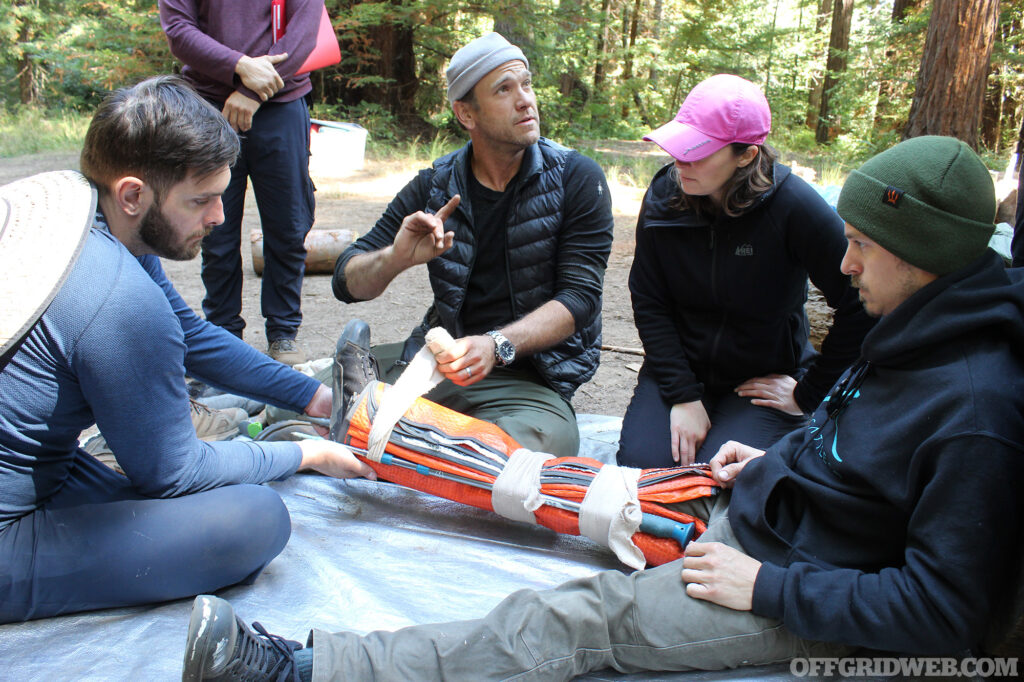
Above: Supplies are limited during a wilderness emergency, and you must find a way to improvise care with what you have, and what you can find from your surroundings.
The foundation of a first aid kit should start with enough gauze, sports tape and ace bandages to handle the amount of people in your group. It can be built out from their depending on every individual's needs with things like medication or epi-pens.
Before you dive into treatment, assess the situation. Is it safe to approach? Are there immediate dangers like fire, falling rocks, or aggressive animals? Check the patient's airway, breathing, circulation, deformities, and environment (ABCDE) to manage the most immediate needs.
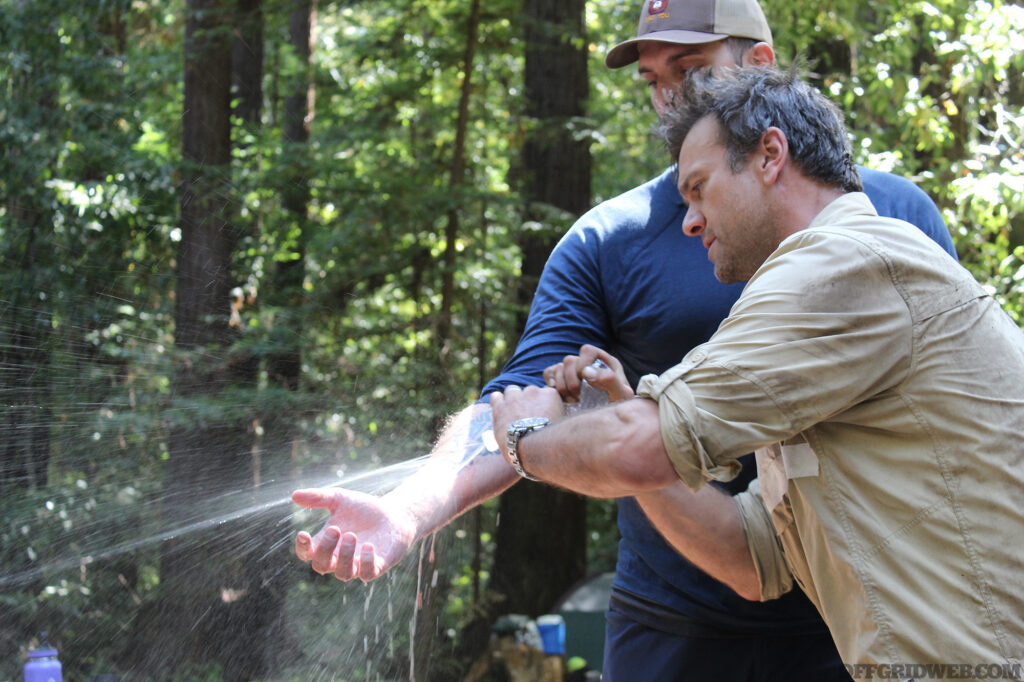
Above: The cap of a water bottle can be perforated to create an improvised wound irrigation device.
Once you've stabilized the immediate situation, you need to decide on your next steps. Can the injured person be safely moved? Do you need to set up a temporary shelter and wait for rescue? Or is it a situation where you need to signal for emergency evacuation? Remember, in wilderness first aid, you're not just treating the injury, you're managing the scene. Your actions should aim to stabilize the patient while also considering the logistics of getting them to more advanced medical care.
Summary
There are many dangers one may face when venturing out into the wilderness, but these are not so different from the dangers faced when venturing out to go to work, shopping or anywhere other than the safety of your home. Fortunately, by simply learning a few skills, these dangers can be mitigated, or even eliminated entirely. Attending classes like these are useful no matter what your skill level is. From novice to expert, we can all benefit by practicing new skills and refreshing old ones. Coyne Survival School is located in California, and learning what their courses have to offer could be the difference between life or death the next time you find yourself far from modern amenities.
Read More
The post Back to School: Survival Skills Certification Key Takeaways appeared first on RECOIL OFFGRID.
By: Patrick Diedrich
Title: Back to School: Survival Skills Certification Key Takeaways
Sourced From: www.offgridweb.com/preparation/coyne-survival-school-survival-skills-certification-review/
Published Date: Thu, 28 Sep 2023 11:00:48 +0000
------------------------
Did you miss our previous article...
https://bushcrafttips.com/bushcraft-news/how-to-live-in-the-woods-for-years-in-comfort
 What is BushcraftSurvival SkillsToolsVideosBushcraft CampsBushcraft KitsBushcraft ProjectsPrivacy PolicyTerms And Conditions
What is BushcraftSurvival SkillsToolsVideosBushcraft CampsBushcraft KitsBushcraft ProjectsPrivacy PolicyTerms And Conditions
